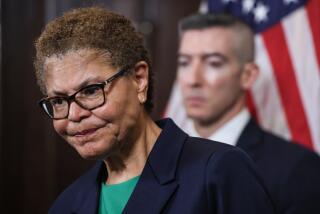L.A. Council Adopts $2.9-Billion Budget
- Share via
After a week of marathon hearings often bristling with mayoral politics, the Los Angeles City Council on Wednesday tentatively adopted a $2.9-billion budget that heavily emphasizes crime-fighting and increased city services.
If Mayor Tom Bradley agrees, in the coming fiscal year, there will be a record number of police officers patrolling streets that will be swept more often. Also, parks will get new swings and slides, publicly owned high-rises such as City Hall will be safer from fire and more potholes will disappear.
Although a dry document, the budget is also a crystal ball of sorts, offering a peek at what is shaping up as a bitter mayor’s race next year between four-term incumbent Bradley and Westside Councilman Zev Yaroslavsky. The two challengers are expected to draw heavily from the thick budget documents to support their respective bids for the city’s highest office.
Key Victories
Despite spirited efforts by Bradley council allies Richard Alatorre and Robert Farrell to hold him in check, Yaroslavsky engineered several key victories during the weeklong budget talks that will likely be splashed across his campaign literature next spring.
Yaroslavsky, as the veteran Finance Committee chairman, unearthed enough money to add 150 more officers to the police force than the 400 proposed by Bradley. If Bradley approves the additional officers, as is expected, the force will climb to a record 7,900 officers within months of the April, 1989, primary.
In another successful maneuver, Yaroslavsky rescued his controversial plan to provide a 35-cent bus fare subsidy by pushing through a vaguely worded $20.8-million proposal that could attack traffic congestion in a variety of ways, including--but not necessarily--bus fare cuts.
Traffic Issue
Bradley may have the last word on the traffic issue. Alatorre predicted that the mayor will reject Yaroslavsky’s hastily conceived catch-all traffic plan, which has attracted only nine of the 10 votes needed to override a potential veto. But a veto could also be risky for the mayor, because it could be construed by hundreds of thousands of bus riders as a Bradley move against lower bus fares, although the measure would not assure lower fares.
Yaroslavsky suffered one significant political defeat in the lengthy budget deliberations. He opposed attempts by the council’s minority members to set aside $2 million for an undefined effort to divert “at-risk” youngsters from gangs. Yaroslavsky said the proposal was too vague.
Although the measure repeatedly fell one vote short of passage, Alatorre, Farrell and Gloria Molina continued to push it in different forms until they finally found the necessary majority for an even higher appropriation of $2.1 million.
Recognizing that he had lost the battle, Yaroslavsky graciously joined the new-found majority, joking after several hours of debate Wednesday: “This is what I’ve been waiting for from the very beginning. Now that you’ve raised it to $2.1 million, I can support it.”
The gang diversion item then passed 13 to 0.
The 1988-89 budget evolves from the most bountiful treasury the city has had since California voters in 1978 used Proposition 13 to squelch what they viewed as rampant government spending. Next year’s $2.92-billion fiscal blueprint for the city is more than 18% higher than the current year’s budget and $1 billion more than just four years ago.
Many council members saw the hefty budget as a way to loosen their belts for the first time in a decade. Consequently, instead of going through another agonizing year of slashing traditional programs, they filed dozens of motions to cure both their district’s long-neglected ills and citywide problems.
Retrofitting High-Rises
One of those citywide problems was only partially addressed. On Tuesday, the council approved a $5-million appropriation to begin the long and expensive process of retrofitting six city high-rises, including City Hall, with automatic sprinklers. The money is only a fraction of the more than $30 million that may be needed, and the city will need to find other funding sources to complete the job if a bond issue on next April’s primary ballot fails.
The budget also relies heavily on so-called temporary taxes imposed five years ago on businesses, utilities and hotel visitors to help shore up shrinking city revenues. Those taxes now appear to be here to stay. An attempt by Councilwoman Joy Picus on Tuesday to lower the utility users tax from 10% to 9% failed miserably.
The record budget, while expanding on existing city services, also leaves the city with the smallest rainy-day fund in several years, City Administrative Officer Keith Comrie said. The council is recommending a reserve of about $20 million, which is $10 million less than Bradley had proposed.
Comrie added that the budget also is within $25 million of the Gann spending limit set by voters for state and local government agencies in 1979. The initiative restricts growth in government spending to certain factors, such as population and cost-of-living increases.
The tentatively adopted budget is expected to receive final approval Tuesday and then be sent to Bradley for consideration. Under the City Charter, Bradley has five working days to approve or veto those changes in his original spending plan. The council would then have five days in which to attempt any overrides.
More to Read
Sign up for Essential California
The most important California stories and recommendations in your inbox every morning.
You may occasionally receive promotional content from the Los Angeles Times.










